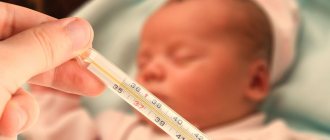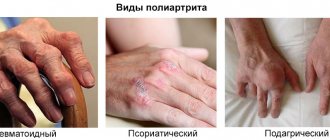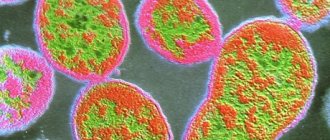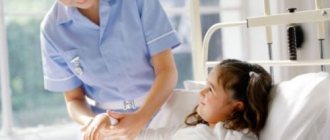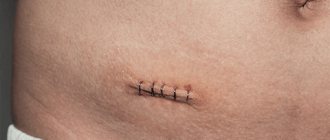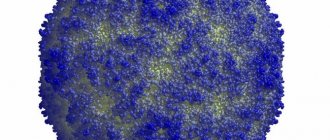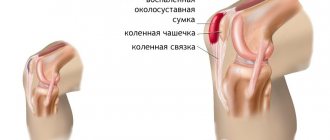Norovirus is an RNA-containing microbe that causes diseases of the gastrointestinal tract. It is highly contagious, resistant and remains viable for a long time in the external environment. In 90% of cases, noroviruses are causative agents of nonbacterial enteritis. Persons of all ages are susceptible to norovirus infection. The spread of germs occurs through direct contact when communicating with a sick person and through the fecal-oral route when consuming contaminated food or water. The incidence of gastroenteritis of norovirus etiology increases in the autumn-winter period. Viral inflammation of the gastrointestinal tract is second in frequency only to the common cold.
The virus was first isolated in the last century from patients with acute gastroenteritis. For a long time, this microbe was called the “Norfolk agent” or Norfolk virus in honor of the American city in which the first cases of the disease were recorded. Subsequently, similar pathologies with similar clinical signs were recorded in different parts of our planet. It was only in 2002 that the microbe received its modern name.
Noroviruses are causative agents of viral gastroenteritis and “stomach flu”, which manifest themselves as severe dyspeptic syndrome. Currently, there are 7 genogroups of norovirus, of which only three are pathogenic for humans: groups I, II, III. Norovirus genotype 2 causes the development of acute intestinal infection in 90% of cases.
What is norovirus?
For the first time, doctors discovered norovirus in the United States in 1972 in the city of Norwalk. That's why for a long time it was called the Norwalk virus. Since then, the virus has spread throughout the world.
Norovirus is not a specific microbe. This concept refers to a whole group of microorganisms. Colloquially, infection with these viruses is also called “norovirus.”
This infection is to blame for every third case of gastroenteritis in children and every second case in adults worldwide.
Most often, outbreaks of this intestinal infection occur between November and March. It especially affects children, the elderly and people with weakened immune systems.
Danger of disease
Complications and consequences that arise from norovirus infection depend on the degree of damage to the human body. The state of the immune system is also important, how capable it is of resisting pathogens.
In most cases, complications after norovirus infection occur as a result of damage to the central nervous system:
- brain tissue swells;
- encephalitis develops;
- convulsive syndrome occurs;
- hearing and visual functions deteriorate;
- epileptic seizures appear;
- the risk of paralysis of one half of the body increases.
Dislocation syndrome can appear in a person after norovirus. The pathological condition is characterized by herniation of the brain, when there is a high probability of stopping the functioning of the cardiovascular or respiratory system.
Symptoms in children
Children with norovirus infection may exhibit different symptoms than adults. Often the disease in children goes away without vomiting, less often only nausea and vomiting without diarrhea appear. Children often experience an increase in temperature; fever may occur, but is very rare.
Children lose water faster and are less able to compensate for water and electrolyte losses. Significant electrolyte abnormalities may occur. This can lead to circulatory problems, kidney failure and seizures.
Babies express abdominal pain often with a high-pitched cry and characteristic twisting of their legs.
To replenish fluids, the child should be given plenty of fluids immediately after the first symptoms appear. You need to feed your child with boiled water, alternating it with rehydron. You can give your child medicinal charcoal. It is necessary to change the diet, exclude dairy products, vegetables, fruits. Give food often and in small portions. Hospitalization is usually needed for young infants or if the child refuses to drink and the mother cannot cope on her own.
Newborns can only get sick if there is a sick person at home. Therefore, it is necessary to isolate the child from the patient and strictly observe hygiene.
To avoid complications, you should consult a doctor in a timely manner.
Diet
Treatment of norovirus infection requires the patient to follow a strict diet. Proper nutrition will not only eliminate negative symptoms, but also reduce the burden on the gastrointestinal tract.
| Recommended Products | Prohibited Products |
|
|
In case of inflammation of the mucous membrane of the gastrointestinal tract, dietary nutrition should be as gentle as possible in order to prevent possible irritation. It is also important to prevent dehydration of the body; you must drink at least 2 liters of clean warm water in small portions every day (boiled or still mineral water, green or herbal tea).
In most cases, norovirus infection occurs without complications. Symptoms disappear on their own after 2-3 days. A person or child will need inpatient treatment if the signs of infection progress and severe dehydration occurs.
You cannot risk your health; you should immediately call a general practitioner or pediatrician. Otherwise, there is a high probability of serious complications.
How is it transmitted?
Norovirus is extremely resistant to adverse environmental influences. These viruses live on surfaces for 12 hours and can withstand temperatures of 60 degrees. Many disinfectants do not kill these microorganisms.
These viruses are highly contagious and aggressive. A small number of viruses that enter the body can cause disease. Even one infected person can cause a local epidemic.
Norovirus infection most often occurs through hands and objects (fecal-oral route). In addition, when a patient defecates and vomits, a huge amount of viruses remains in the environment and can enter the mouths of healthy people.
Infection can also occur through contaminated water and food. At one time, there were outbreaks of the disease from salads and fruits.
Diseases are quite common in public institutions with poor compliance with sanitary and hygienic standards.
During the cold season, the human immune system is under strain, so outbreaks of the disease occur especially often during the winter months. In addition, doctors noticed a connection between the frequency of virus infections and worsening living conditions, nutrition and stress.
It is important to know that people with norovirus remain contagious for 48 hours after all acute symptoms have disappeared. Viruses can remain in stool for up to 14 days or even several weeks after the onset of the disease.
Active and impetuous
Norovirus is a highly contagious and persistent pathogen: the infectious dose includes only 10-100 viral particles. Even small pieces of dust containing norovirus can cause illness. Wet cleaning using standard detergents and alcohol-containing products does not guarantee its elimination. Norovirus survives freezing, drying, and can withstand heat up to 60 degrees. He dies from exposure to chlorine-containing agents.
to contents ^
Do I need to see a doctor?
If you suspect a norovirus infection, you should consult a doctor, since a sick person is highly contagious to others.
Diagnosis occurs in three stages. First, a medical history (anamnesis) is collected. The doctor asks the patient what he is complaining about, how he is feeling, what he has eaten, and whether he has interacted with people with similar symptoms.
During a physical examination, the doctor listens and palpates the abdomen.
It is very important to exclude other, more serious diseases with similar symptoms. After this, laboratory tests are performed to definitively confirm the diagnosis of norovirus infection. The material for them is stool and vomit samples.
Diagnostics
Diagnosis of norovirus infection includes a number of laboratory tests:
- PCR is a highly sensitive technique that can determine the content of viruses in the material under study and identify its type.
- The second no less effective, informative and accurate diagnostic method is enzyme immunoassay.
- Serological study - determination of specific antibodies in the blood to noroviruses using the RA, RPGA and RNGA methods.
- Patients also need to donate blood and urine for general clinical tests to detect inflammation.
Treatment
There is no drug treatment. The main thing in treatment is to compensate for the symptoms. If the disease is mild, treatment at home is possible. The main thing in this case is to restore the loss of water and electrolytes. Electrolytes are salts such as sodium, potassium, etc., which are lost in large quantities through vomiting and diarrhea. Large losses of these substances are dangerous, as they can lead to loss of consciousness or heart rhythm disturbances.
It is recommended to drink ready-made solutions of glucosalan and rehydron. In addition, you need to drink non-carbonated mineral water and unsweetened herbal teas. Medical nutrition is recommended, diet 4b.
There are a number of rules for treating diarrhea at home.
If the symptoms are severe and if it is not possible to replace the fluid at home (this often happens in children and the elderly), you should call an ambulance and, possibly, admit the patient to a hospital. In a hospital setting, glucose-salt liquid is administered intravenously.
Patients with norovirus should take care of themselves. Bed rest is recommended.
Symptoms
Since norovirus intestinal infection is provoked by the influence of a pathogenic bacterium, it is advisable to note the incubation period, which in this case lasts from 1 to 3 days.
The first clinical signs of norovirus gastroenteritis are considered to be:
- sudden onset of nausea;
- persistent and intense vomiting;
- watery consistency of stool.
In people with weakened immune systems, children and women during pregnancy, at the beginning of the disease, the following is also noted:
- increase in temperature above 38 degrees;
- attacks of headache;
- constant drowsiness;
- cutting pain in the abdominal area;
- decreased appetite;
- sore throat;
- nasal congestion;
- increased tearfulness;
- severe stomach colic;
- pain in the upper and lower extremities.
If treatment of the disease was started at this stage of its course, then complete recovery occurs in about a few days. However, in the absence of qualified assistance, there is a high probability of signs of progressive dehydration in adults and children, which is caused by fluid loss due to frequent vomiting and diarrhea. In such situations, the symptoms will be presented:
- thirst;
- dizziness;
- causeless fatigue;
- dry mouth, despite ingestion of liquid;
- darkening of urine;
- dry lips and mucous eyes;
- rare urge to empty the bladder, namely, less than 3 times a day.
In order to get rid of such signs, you need to drink plenty of water, however, if you do not replenish lost fluid, the following symptoms of norovirus infection may appear:
- dry skin;
- complete absence of urine;
- sunken eyes;
- general malaise;
- increased heart rate;
- fluctuations in blood tone;
- weak pulse;
- attacks of loss of consciousness;
- increased irritability;
- decrease in local temperature of the upper and lower extremities.
Prevention measures
- Prevention is compliance with sanitary and hygienic standards.
- If there is a person with norovirus in the house, it is necessary to disinfect all the things that he uses, all door handles, toilets and sinks.
- Bed linen should be washed separately at 90 degrees.
- Disinfect your hands regularly.
- These measures should be followed even after the vomiting and diarrhea disappear, since the person remains contagious for several weeks after feeling better.
To avoid getting infected, you must follow these simple rules:
- wash your hands before eating and after using the toilet,
- drink clean water, do not drink milk sold on tap raw,
- wash vegetables and fruits thoroughly,
- fry and boil meat, fish, poultry, seafood, eggs well,
- Do not store prepared food at room temperature for more than two hours,
- Store salads with mayonnaise in the refrigerator for no more than 18 hours,
- Do not store food in the refrigerator unopened.
Norovirus during pregnancy
Especially often, expectant mothers are concerned about what will happen if an infection occurs. If a woman becomes infected during pregnancy, it is not scary for the fetus. The norovirus won't harm him.
However, vomiting or diarrhea can lead to premature contractions and cause premature labor. Therefore, expectant mothers should consult a doctor for advice on how to manage symptoms and ensure that they are getting enough fluids, electrolytes and nutrients.
Etiology
Norovirus is not a specific bacterium, but a whole group of microorganisms, numbering about 25 different strains. The bacillus that causes gastrointestinal diseases is highly contagious, i.e. infectiousness, as well as resistance to environmental conditions, where it remains viable for a long time.
In the vast majority of situations, norovirus intestinal infection is diagnosed between November and March, however, this does not mean that the incidence is not observed at other times of the year.
It is also worth noting that there are currently 7 genotypes of the virus known, but only 3 of them are dangerous to humans. It is noteworthy that in approximately 90% of cases, norovirus genotype 2 acts as a provocateur of the disease.
This pathological agent is transmitted in only 3 ways:
- food - realized in the process of eating unwashed vegetables, berries and fruits;
- waterborne – infection occurs when accidentally entering or drinking contaminated water;
- household contact is the most common mechanism of transmission of pathogenic microorganisms. It is carried out in the absence of the habit of washing hands after going outside, using poorly washed dishes, or coming into contact with household items touched by an infected person.
A patient who has norovirus in his body will be contagious from the moment the bacillus penetrates, throughout the entire period of the disease, and for about another 3 days from the moment all clinical manifestations stop.
How is norovirus different from rotavirus?
At first glance, these two diseases are similar. They have common routes of infection, such as diarrhea, vomiting, weakness, nausea, sweating.
However, these are completely different diseases. Rotavirus begins acutely, with diarrhea and increased body temperature. Norovirus is more insidious. Body temperature does not increase in the first days. It starts with vomiting, not diarrhea. Moreover, a single vomiting is possible and then, if you follow the diet, there seem to be no manifestations. Only weakness, sweating, and headaches bother me a little.
As a result, a person may mistake these symptoms for quite a long time for mild food poisoning. And during this period, the norovirus continues its destructive effect. The virus releases toxins that poison the body and cause dehydration. Therefore, if a single case of vomiting is accompanied by a deterioration in the general condition, it is better to consult a doctor.
The final difference is that rotavirus infection occurs throughout the year. Norovirus is especially active in winter. Sometimes it is called “winter vomiting.”
data-matched-content-rows-num=”4.2″ data-matched-content-columns-num=”1.2″ data-matched-content-ui-type=”image_stacked” data-ad-format=” autorelaxed">
Immunoprophylaxis
In Europe, there are specialized rotavirus vaccines. Some countries have already included them in the National Schedule of Preventive Vaccinations for Children. Vaccinations are given to 2-month-old children for the first time. 2 or 3 doses of oral vaccine are given at regular intervals for up to 6 months.
There are two types of vaccines, which consist of the most common rotavirus serotypes and their combinations. In European countries the following are often used:
- RotaTeq (RotaTek)
. Live attenuated pentavalent (serotypes G1, G2, G3, G4 and P1) oral vaccine, administered 3 times; - Rotarix
. Live attenuated monovalent (G1P) oral vaccine, administered in 2 doses.

